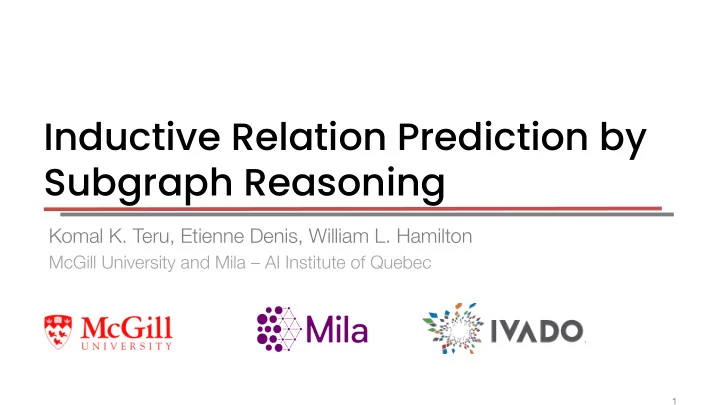

Inductive Relation Prediction by Subgraph Reasoning Komal K. Teru, Etienne Denis, William L. Hamilton McGill University and Mila – AI Institute of Quebec 1
Relation prediction in Knowledge graphs Automatically expand and complete existing knowledge bases. Needs relational reasoning to make inference. Applications in e-commerce, medicine, materials science… 2
Transductive relation prediction Training graph Test graph 3
Embeddings-based methods Encode each node to a low-dimensional embedding ▪ Jenifer Philant. mother_of n o i t a p u c c o Holly. located_in Savanna lives_in h Marie mother_of spouse_of L.A lives_in located_in ? LeBron part_of l y i v b _ e d e s d teammate_of n _ u i o n f Lakers Akron part_of f a School v _ n b a _ t e a m s p o u s A. Davis e _ o f Britney 4
Embeddings-based methods Encode each node to a low-dimensional embedding ▪ . . . Jenifer Philant. . mother_of . n . o ▪ Use the derived embeddings i t a p u c c o Holly. . . n . . i to make predictions _ d Savanna lives_in e t a . . c h o l . Marie . . mother_of spouse_of . (TransE, RotatE, etc.) . L.A . lives_in . . . located_in ? LeBron part_of . lives_in founded_by . teammate_of . . Lakers Akron part_of fav_nba_team . School . . s p o u s e A. Davis _ o f . . . Britney . . 5
Embeddings-based methods Encode each node to a low-dimensional embedding ▪ . . . Jenifer Philant. . mother_of . n . o ▪ Use the derived embeddings i t a p u c c o Holly. . . n . . i to make predictions _ d Savanna lives_in e t a . . c h o l . Marie . . mother_of spouse_of . (TransE, RotatE, etc.) . L.A . lives_in . . . located_in LeBron part_of . lives_in founded_by . teammate_of . ▪ Can’t make predictions on . Lakers Akron part_of fav_nba_team . School . new nodes. . s p o u ? s e A. Davis _ o f . . . t e a m Britney m . a t e _ o f K u z m a . No embedding! 6
Limitations of transductive relation prediction ▪ Problematic for production systems ▪ Need to re-train to deal with new nodes (e.g., entities, products) ▪ Predictions can become stale. ▪ Too many parameters ▪ Most transductive approaches have O(|V|) space complexity. ▪ Biases model development ▪ Focus on “embedding”-based methodologies. ▪ Static and unrepresentative benchmarks 7
Inductive learning: evolving data ? K u z m a part_of Training graph Test graph 8
Inductive learning: new graphs Training graph Test graph 9
GraIL: Inductive learning using GNNs ▪ A novel approach to learn entity-independent relational semantics (rules) ▪ SOTA performance on inductive benchmarks ▪ Extremely parameter efficient 10
GraIL: Inductive learning using GNNs ▪ Idea 1 : Apply graph neural networks (GNNs) on the subgraphs surrounding candidate edge. ▪ Idea 2: Avoid explicit rule induction. ▪ Idea 3: Ensure model is expressive enough to capture logical rules. 11
GraIL: Relation prediction via subgraph reasoning 1. Extract subgraph around 2. Assign structural labels 3. Run GNN on the candidate edge to nodes extracted subgraph 12
GNN architecture Neural message-passing approach 13
GNN architecture Neural message-passing approach Learn a relation-specific transformation matrix Use attention to weigh information coming from Separately aggregate across different neighbors different types of relations 14
GNN architecture Neural message-passing approach Information aggregated from the neighborhood Information from the nodes embedding at the previous layer 15
GraIL can learn logical rules Theorem (Informally): GraIL can learn any logical rule of the form: Example of such a rule: These “path-based” rules are the foundation of most state-of-the-art rule induction systems. 16
State-of-the-art inductive performance • Constructed inductive versions of three standard benchmarks. • Sampled mutually exclusive subgraphs of varying sizes • Tested four inductive datasets per each benchmark. Table: AUC-PR results on inductive relation prediction 17
State-of-the-art inductive performance • Compared against state-of-the-art neural rule induction methods • Also compared against the best statistical induction approach. Table: AUC-PR results on inductive relation prediction 18
State-of-the-art inductive performance • Key finding: GraIL outperforms all previous approaches on all datasets (analogous results for hits@k) Table: AUC-PR results on inductive relation prediction 19
Added benefits GraIL is extremely parameter efficient compared to the existing neural rule-induction methods. GraIL can naturally leverage external node attributes/embeddings 20
Ensembling in the transductive setting Each entry is a pair-wise Table: Ensemble AUC-PR results on WN18RR ensemble of two methods 21
Ensembling in the transductive setting Each entry is a pair-wise Table: Ensemble AUC-PR results on WN18RR ensemble of two methods GraIL has the lowest performance on its own 22
Ensembling in the transductive setting Each entry is a pair-wise Table: Ensemble AUC-PR results on WN18RR ensemble of two methods GraIL has the lowest performance on its own… But ensembling with GraIL leads to the best performance 23
Architecture details are important! Naïve subgraph extraction Table: Ablation study AUC-PR results causes severe overfitting Our node labelling and attention schemes are crucial for the theory and for strong performance. 24
Future directions Extracting interpretable rules from GraIL. ● Expanding the class of first-order logical rules that can be represented ● beyond the chain-like rules focussed in this work. Extending the generalization capabilities to new relations added to the ● knowledge graphs. 25
Thank you! Komal K. Teru komal.teru@mail.mcgill.ca Etienne Denis etienne.denis@mail.mcgill.ca William L. Hamilton wlh@cs.mcgill.ca Paper: https://arxiv.org/abs/1911.06962 Code and data: https://github.com/kkteru/grail 26
Recommend
More recommend